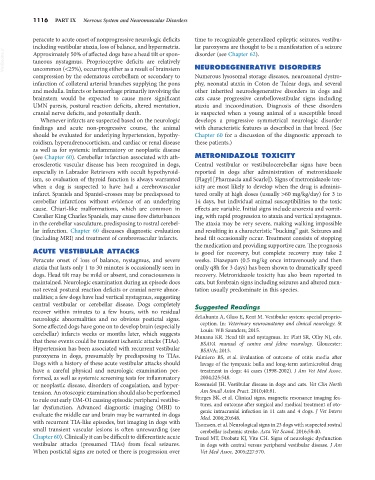Page 1144 - Small Animal Internal Medicine, 6th Edition
P. 1144
1116 PART IX Nervous System and Neuromuscular Disorders
peracute to acute onset of nonprogressive neurologic deficits time to recognizable generalized epileptic seizures, vestibu-
including vestibular ataxia, loss of balance, and hypermetria. lar paroxysms are thought to be a manifestation of a seizure
VetBooks.ir Approximately 50% of affected dogs have a head tilt or spon- disorder (see Chapter 62).
taneous nystagmus. Proprioceptive deficits are relatively
NEURODEGENERATIVE DISORDERS
uncommon (<25%), occurring either as a result of brainstem
compression by the edematous cerebellum or secondary to Numerous lysosomal storage diseases, neuroaxonal dystro-
infarction of collateral arterial branches supplying the pons phy, neonatal ataxia in Coton de Tulear dogs, and several
and medulla. Infarcts or hemorrhage primarily involving the other inherited neurodegenerative disorders in dogs and
brainstem would be expected to cause more significant cats cause progressive cerebellovestibular signs including
UMN paresis, postural reaction deficits, altered mentation, ataxia and incoordination. Diagnosis of these disorders
cranial nerve deficits, and potentially death. is suspected when a young animal of a susceptible breed
Whenever infarcts are suspected based on the neurologic develops a progressive symmetrical neurologic disorder
findings and acute non-progressive course, the animal with characteristic features as described in that breed. (See
should be evaluated for underlying hypertension, hypothy- Chapter 60 for a discussion of the diagnostic approach to
roidism, hyperadrenocorticism, and cardiac or renal disease these patients.)
as well as for systemic inflammatory or neoplastic disease
(see Chapter 60). Cerebellar infarction associated with ath- METRONIDAZOLE TOXICITY
erosclerotic vascular disease has been recognized in dogs, Central vestibular or vestibulocerebellar signs have been
especially in Labrador Retrievers with occult hypothyroid- reported in dogs after administration of metronidazole
ism, so evaluation of thyroid function is always warranted (Flagyl [Pharmacia and Searle]). Signs of metronidazole tox-
when a dog is suspected to have had a cerebrovascular icity are most likely to develop when the drug is adminis-
infarct. Spaniels and Spaniel-crosses may be predisposed to tered orally at high doses (usually >60 mg/kg/day) for 3 to
cerebellar infarctions without evidence of an underlying 14 days, but individual animal susceptibilities to the toxic
cause. Chiari-like malformations, which are common in effects are variable. Initial signs include anorexia and vomit-
Cavalier King Charles Spaniels, may cause flow disturbances ing, with rapid progression to ataxia and vertical nystagmus.
in the cerebellar vasculature, predisposing to rostral cerebel- The ataxia may be very severe, making walking impossible
lar infarction. Chapter 60 discusses diagnostic evaluation and resulting in a characteristic “bucking” gait. Seizures and
(including MRI) and treatment of cerebrovascular infarcts. head tilt occasionally occur. Treatment consists of stopping
the medication and providing supportive care. The prognosis
ACUTE VESTIBULAR ATTACKS is good for recovery, but complete recovery may take 2
Peracute onset of loss of balance, nystagmus, and severe weeks. Diazepam (0.5 mg/kg once intravenously and then
ataxia that lasts only 1 to 30 minutes is occasionally seen in orally q8h for 3 days) has been shown to dramatically speed
dogs. Head tilt may be mild or absent, and consciousness is recovery. Metronidazole toxicity has also been reported in
maintained. Neurologic examination during an episode does cats, but forebrain signs including seizures and altered men-
not reveal postural reaction deficits or cranial nerve abnor- tation usually predominate in this species.
malities; a few dogs have had vertical nystagmus, suggesting
central vestibular or cerebellar disease. Dogs completely Suggested Readings
recover within minutes to a few hours, with no residual
neurologic abnormalities and no obvious postictal signs. deLahunta A, Glass E, Kent M. Vestibular system: special proprio-
Some affected dogs have gone on to develop brain (especially ception. In: Veterinary neuroanatomy and clinical neurology. St
Louis: WB Saunders; 2015.
cerebellar) infarcts weeks or months later, which suggests Munana KR. Head tilt and nystagmus. In: Platt SR, Olby NJ, eds.
that these events could be transient ischemic attacks (TIAs). BSAVA manual of canine and feline neurology. Gloucester:
Hypertension has been associated with recurrent vestibular BSAVA; 2013.
paroxysms in dogs, presumably by predisposing to TIAs. Palmiero BS, et al. Evaluation of outcome of otitis media after
Dogs with a history of these acute vestibular attacks should lavage of the tympanic bulla and long-term antimicrobial drug
have a careful physical and neurologic examination per- treatment in dogs: 44 cases (1998-2002). J Am Vet Med Assoc.
formed, as well as systemic screening tests for inflammatory 2004;225:548.
or neoplastic disease, disorders of coagulation, and hyper- Rossmeisl JH. Vestibular disease in dogs and cats. Vet Clin North
tension. An otoscopic examination should also be performed Am Small Anim Pract. 2010;40:81.
to rule out early OM-OI causing episodic peripheral vestibu- Sturges BK, et al. Clinical signs, magnetic resonance imaging fea-
lar dysfunction. Advanced diagnostic imaging (MRI) to tures, and outcome after surgical and medical treatment of oto-
genic intracranial infection in 11 cats and 4 dogs. J Vet Intern
evaluate the middle ear and brain may be warranted in dogs Med. 2006;20:648.
with recurrent TIA-like episodes, but imaging in dogs with Thomsen, et al. Neurological signs in 23 dogs with suspected rostral
small transient vascular lesions is often unrewarding (see cerebellar ischemic stroke. Acta Vet Scand. 2016;58:40.
Chapter 60). Clinically it can be difficult to differentiate acute Troxel MT, Drobatz KJ, Vite CH. Signs of neurologic dysfunction
vestibular attacks (presumed TIAs) from focal seizures. in dogs with central versus peripheral vestibular disease. J Am
When postictal signs are noted or there is progression over Vet Med Assoc. 2005;227:570.

